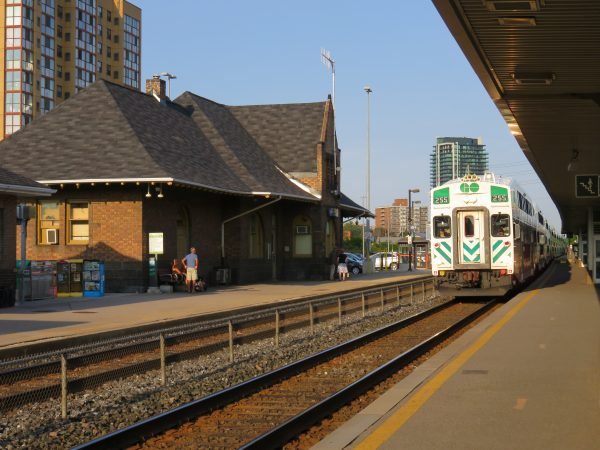GO Transit commuter train at Brampton Station, on the Toronto-Kitchener rail corridor
Last week, Premier Kathleen Wynne announced the commencement of an Environmental Assessment for a new high-speed rail line to Southwestern Ontario. Phase I would connect Toronto’s Union Station and Pearson Airport with Guelph, Kitchener, and London; Phase II would continue to Windsor, with a potential stop in Chatham.
Former federal Transport Minister David Collenette was assigned to study the high-speed corridor; his report is now public on the Ministry of Transportation’s website. The recommended plan proposes a train service that could operate at speeds up to 250 km/h, making it a true high speed line (though slower than many lines in Europe and East Asia, which have cruising speeds between 270 and 320 km/h). The estimated cost of the project $21 billion, in return for reducing travel times from Toronto to Windsor to a mere two hours.
During his time as Transport Minister under Prime Minister Jean Chretien, Collenette backed incremental VIA Rail improvements, as well as VIA-FAST, a higher-speed train service between Toronto, Ottawa, and Montreal. Those proposed improvements were cancelled when Paul Martin became prime minister. Currently, VIA is pushing for a revised version of that previous plan. Collenette also pushed hard for a rail link between Toronto Pearson International Airport and Union Station, a fundamentally flawed proposal known as “Blue 22.” That airport rail link proposal was later relaunched as a provincial project and opened as UP Express in 2015.

Proposed High Speed Rail system for Southwestern Ontario
An option for a 300 km/h HSR service was also studied, but found to be even more expensive, requiring more dedicated tracks. The recommended 250 km/h option will allow the service to use much of the existing Toronto-London and London-Windsor corridors.
For southwestern Ontario, high speed rail could be a boon. Kitchener-Waterloo is a major educational and technological hub. Faster and more frequent rail service will benefit university students, tech workers, and other commuters, perhaps including those priced out of the Toronto housing market. London’s economy has taken some hits in recent years, so bringing it within commuting distance to Toronto and K-W gives residents there more options.
Between Toronto and Kitchener, the report assumes two off-peak HSR trains an hour, and one GO train every hour, making local stops. It also assumes that GO RER service will continue to terminate at Bramalea, a poor location to terminate regional rail services, as downtown Brampton is one stop away. Building the new freight bypass route, described below, will allow many more passenger trains to pass through Downtown Brampton, including GO RER trains. It would be a shame if the HSR plans pushed aside regional and local needs.
Stratford and St. Marys, which are only served by VIA trains (and have no intercity coach service), will also have to be considered, as they will be bypassed by HSR. As well, towns and cities elsewhere in southwest Ontario, such as Simcoe, Tillsonburg, Wallaceburg, and St. Thomas, have no bus or rail access. For less than the $15 million pledged for the HSR EA, the province could fund several years’ worth of basic intercity bus service to connect these communities together.
Unless these assumptions change, Brampton residents will see twice as many trains speed by their downtown core than stop, and other smaller communities might see their rail service disappear.
In Canada, we have an abysmal record of proposing high-speed rail projects, but never following through. Even VIA’s less ambitious plan for dedicated tracks and new equipment to provide more frequent and reliable service, with somewhat faster travel times, is not yet secure.
There is already a Toronto-Kitchener-London service: two VIA trains operate daily in each direction along the entire route, while GO Transit operates more frequent weekday trains to Brampton and four weekday round trips to Kitchener. Before the 1990 Brian Mulroney-era VIA cuts, there were five round trips on this line. In the 1980s, the fastest VIA train between Toronto, Kitchener, and London took 3 hours, 2 minutes; today, the fastest train is 3 hours, 22 minutes.
A simpler plan would address many of the same issues the high-speed rail proposal seeks to solve. It can be done incrementally, reducing upfront costs. As an additional bonus, it would serve many more ridings, especially those suburban constituencies that the Liberals will seek to hold onto in next year’s election.
- Dedicated tracks. On the Toronto-Kitchener-London corridor, this means building a new rail corridor, known as “The Missing Link” for freight trains between Halwest (near Bramalea GO Station) and Milton. This new route would divert Canadian National (CN) freight trains that currently pass through Brampton and Georgetown on the Toronto-Chicago mainline. Potentially, Canadian Pacific (CP) trains passing through Toronto and Mississauga could also be diverted, freeing up capacity on GO Transit’s Milton Line. CN freight traffic limits the frequency and speed of GO Transit rail service to Brampton and Kitchener. Moving the through freight trains would allow for frequent, electrified, GO RER service beyond Bramalea, as currently proposed. CN is interested in partnering with the province to build this link; CP has not expressed interest.

Map of the “Missing Link” from a 2015 IBI Group report - Rail improvements. Between Georgetown and Kitchener, the railway is owned by Metrolinx, and hosts four weekday GO Transit trains in each direction, two daily VIA trains in each direction, and several Goderich-Exeter Railway (GEXR) freight trains. For the most part, the track is in good shape, but has several slow sections, including a two-kilometre section west of Guelph Central Station where trains crawl at 10 miles an hour (16 km/h).Improving rail speeds in central Guelph will be expensive, especially where the railway runs in the middle of residential Kent Street, but it will be worth it. Beyond Kitchener, the track is leased and maintained by GEXR, which has allowed the rails to deteriorate. Slow speeds are acceptable by a no-frills short line freight operator, determined to minimize maintenance costs, but not so for passenger rail. VIA trains are consistently late because of the condition of track, especially between Stratford and London. Purchasing the track, installing welded rail, and improving grade crossings will substantially improve reliability and speeds on this corridor. Incremental improvements, such as grade separations, improved signalling, and new passing tracks, would permit frequent, reliable, and faster rail service.
- A new train fleet. Via Rail’s coaches are nearing the end of their useful lives. Among the rolling stock used on the Toronto-Kitchener-London service are HEP-I and HEP-II coaches built in the 1950s and refurbished several times since. GO Transit’s commuter coaches are acceptable for shorter trips, but are uncomfortable for long-distance travel. With the completion of the “Missing Link” and the acquisition of the Kitchener-London rails, it would be possible to electrify the entire corridor. Electric trains benefit from faster acceleration times, especially electric multiple units.
Some of these improvements can be started within the next year, before the 2018 provincial election. If the province wants to show that it’s serious about providing effective rail service to Kitchener and London, there’s no need for another high-speed rail study. Simply continue the work on the “Missing Link,” plan for GO RER to continue west of Bramalea GO, improve the existing rail infrastructure, and acquire the optimal fleet for medium-distance rail services. Once that is complete, planning for even higher speeds, possibly with a new purpose-built alignment, should begin.
Canadians have been teased with high-speed rail proposals that never get anywhere (best mocked by Rick Mercer’s infamous parody), meanwhile existing rail infrastructure is neglected and intercity services are cut. While the provincial government studies the feasibility of a high-speed rail project, it’s prudent to move forward with a sensible plan that can start right now.
An earlier version of this article appeared on the author’s personal blog.




2 comments
What about Windsor?
Re: “Among the rolling stock used on the Toronto-Kitchener-London service are HEP-I and HEP-II coaches built in the 1950s and refurbished several times since.” Several of them were actually built in the 1940s.